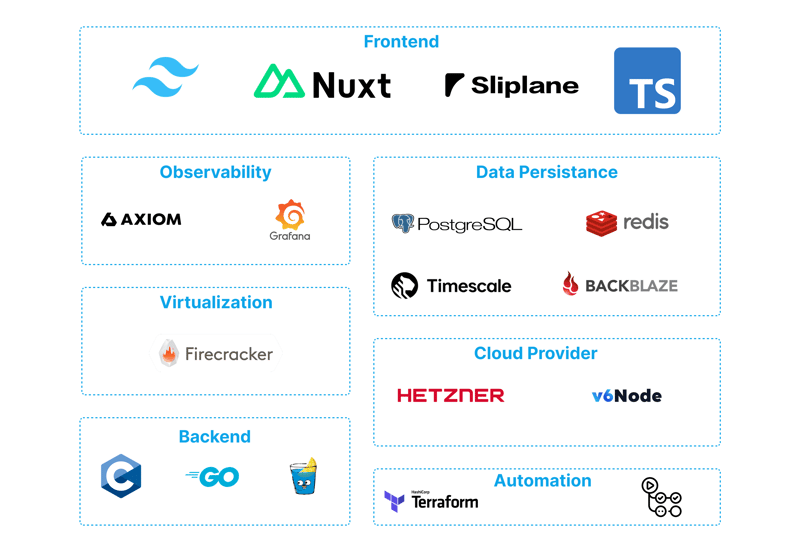The Tech Stack of a Cloud Computing Startup

At Sliplane.io, we’ve put together a tech stack that gets the job done — fast, reliable, and most importantly, easy to maintain and operate.
Here’s a quick rundown of what we’re working with, from frontend to backend and everything in between.
Frontend
For the frontend we’re going a bit against the grain of current webdev trends and bet on Nuxt (of course with Typescript and Tailwind) as our framework of choice. This is mostly because Lukas (the co-founder) is a long-term Nuxt.js fan and sponsor! Of course, the frontend is completely hosted on sliplane for proper dogfooding, with Cloudflare as a CDN in front because script kiddies like to test their DDOS scripts on us :).
Observability
To keep tabs on what’s happening, we use Axiom for logs and Grafana for dashboards and alerts. We pipe all of our logs from most services straight into Axiom and have some pre-defined filters there that help us understand whats going on. With Grafana we have a bunch of custom dashboards that help us triage issues, and more importantly, alert us if some metrics are looking off. Without Grafana, Sliplane could not exist!
Data Persistence
I (Jonas) am not the biggest fan of data management and database operations, so we try to keep this simple. Our main database is Postgres, with the Timescale extension for analytics stuff. Postgres and Timescale has been absolutely amazing so far. We’ve scaled far beyond what I thought would be possible and had to do basically 0 optimizations, even though our entire analytics stack with hundreds of millions of rows is all in Postgres! Oh and of course, Postgres is also hosted at Hetzner.
Redis handles caching to keep things quick, and we stash blobs like Backups (encrypted at rest of course) in Backblaze for cheap, dependable object storage.
Fun fact: At backblaze we pay more for S3 transactions (so API requests) than the storage. There is probably some optimization potential there
Backend
I’ve been writing Go for over 6 years, so picking Go as our main backend language was a no brainer, especially considering the great integrations into the general infra space. Most infra code is go, so that helps a lot. As a framework we use Go-Gin, but honestly we could also just use the native http lib. We also have a tiny part of code in C for some cheeky eBPF stuff we got running. YES, we could write that in Rust, but with eBPF the benefits are negligible and C was the first language I learned as a kid:)
Automation
We manage infrastructure with Terraform and lean heavily on GitHub Actions for CI/CD. Very simple but it works! Oh and a lot of bash scripts of course.
Cloud Providers
We run most of our stuff on Hetzner—cloud, bare-metal, even the DNS. It’s solid, doesn’t break the bank and we have a good relationship with them. For dev work, we’ve got some things on v6node to play around with.
Virtualization
For virtualization, we’re using Firecracker. It’s lightweight, secure, and lets us spin up micro-VMs without crazy overhead. It’s pretty fun to play around with, so do it if you’re interested in that kind of stuff!
Utils
Of course there are a bunch more tools that we use, some great, some not. Two notable ones are Crisp for customer support and AWS SES for sending out emails (we send out quite a lot of transactional emails!).
That’s the gist of our stack at Sliplane.io. It’s practical, it works, and it allows us to have great reliability with a tiny team. More to share down the road as we keep building!
Cheers,
Jonas












 Why Your Web App Feels Slow? Real-Time WebSockets with Node.js Might Be the Answer!
Why Your Web App Feels Slow? Real-Time WebSockets with Node.js Might Be the Answer!